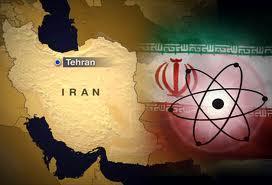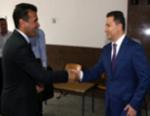
As Iran buries one of its assassinated nuclear scientists, Mostafa Ahmadi-Roshan, the mass media are in a frenzied whirlpool of confusing reports with a total lack of geopolitical understanding of the current situation between Iran and the West. They make conflicting statements and give a distorted interpretation of the situation in the Middle East. Putting aside these robotic statements, let’s analyze the facts that are often not reported or not currently analyzed by the mainstream media.
The Russians and the Chinese, despite voicing their opposition to the US and EU sanctions against Iran, are first, displeased with the Iranians’ strong rhetoric. The Russians have pressured the Iranians to agree to a UN sponsored International Atomic Energy Agency (IAEA) inspections to be conducted from the end of January through the beginning of February. Also, Russia and China have made it clear to the Iranians that they have high expectations that the meeting with the permanent five UN members, plus Germany, to be held in Turkey, will be this time successful. Specifically, the Russians have made clear to the Iranians that they should agree to certain terms and conditions posed by the West. Iran has mentioned that it’s ready to talk, but with the assurance that the West will stop meddling in its internal affairs. Second, Russia and China are already maneuvering to a neutral position should an armed conflict between Iran and the West break out. They will not come to the aid of Iran in a military conflict. Here are the facts that support this supposition: Through secret channels, Russia has told Iran that they need to facilitate a more open dialogue with the West. The Russian Foreign Minister told the press that “Hopefully, Iran will listen to our opinion about the need for further close cooperation with the IAEA.” In the meantime, China has signaled its intention to free itself from Iranian oil to protect their interests if a war was to break out between Iran and the West. In an important up-coming trip to Saudi Arabia, Qatar, and the UAE, Chinese Prime Minister Wen Jiabao will sign important economic agreements with these countries. For China, getting the oil that it needs is paramount to protect its economy. After Iran threatened to close the Strait of Hormuz, China is anticipating a possible attack on Iran and is trying to secure alternative resources for its crude oil needs. It appears that Iran itself would have a lot to loose from a possible disruption of oil supplies in the Strait of Hormuz.
Among all the ridiculous headlines from the mass media, one stuck in my mind. This headline, from a very important newspaper that shall be left unnamed, was titled, “The Covert War on Iran has Started.” It was published the day after the assassination of Roshan. It is interesting to note that the news in this case is not the starting of a covert war on Iran, but the total lack of understanding of the current events unfolding inside of Iran. The real news is that the covert war on Iran started years ago; it is only now reaching an escalation point. Mr. Roshan is officially the fourth Iranian citizen related to the Iranian nuclear program that has been assassinated by “terrorist acts.” The modus apparandi is the same: One or two motorcycles approach the vehicle at a high rate of speed, and then the rider(s) uses a magnetic bomb which attaches itself to the vehicle, blowing the victim and the vehicle itself to pieces. The assassination of Roshan happened on the exact same date, one year after, another scientist working on Iran’s nuclear program, Massoud Ali Mohammadi, was killed in the exact same fashion. The killing of the scientists is in combination with several explosions of nuclear plants and Iranian enrichment facilities that have been going on for the last three years. Just in November of last year, an explosion in the area of Isfahan destroyed a nuclear plant. In October 2010, missile explosions also destroyed a Revolutionary Guards army base. This is in addition to the frustration among the Iranians for the incursion of American drones into Iranian territory. The Obama Administration is particularly fond of using drones. These drone incursions are used for sabotage and spying missions. It is believed that last November, one of these drones was the cause of an explosion that killed Major General Hassan Moghaddam, Head of the Iranian Missile Program, outside of Tehran. The Iranian government has downplayed some of these explosions. Trying to conceal these explosions or by denying that those explosions are caused by terrorist attacks, the Iranian government is mainly trying to keep the citizens from discovering the extent to which foreign intelligence agencies are currently freely operating in the Iranian territory. Elements of the Iranian opposition, Kurdish fighters, and Pakistani-based Sunni extremists called Jundallah, are recruited by the West’s Intelligence communities to carry on some of these covert operations within Iran. The other covert war currently enacted against Iran is the speculation in act against the Iranian Central Bank and its currency. After the assassination of Roshan, all the media were quick to point to the Mossad as the main responsible party for the killing. But, there are now several foreign agencies, besides the Mossad, engaging in covert operations inside of Iran. Elements of the CIA, British SIS, and the Saudi Arabian GIP are also working within Iranian territory.
One of the most effective weapons at the disposal of the West is cyber warfare. Cyber warfare is becoming increasingly more important, replacing traditional forms of warfare. The attacks on September 11 were a clear example of 4th generation warfare. The covert war on Iran is technically an asymmetric warfare. Cyber warfare goes beyond the last four traditional generations of warfare and becomes an integrated part of modern warfare. Countries such as Russia, China and the US are on the forefront of this new concept. Even a nation such as North Korea has made great strides in the area of cyber warfare.
A year ago, a massive cyber-attack seriously derailed the Iranian nuclear program. Conservative estimations are that Iran would have already had a nuclear weapon if it wasn’t for this cyber-attack. The name of this CIA-Mossad created superbug was “Stuxnet.” According to non-verifiable sources, the Stuxnet attack caused thousands of Iran’s centrifuges to become useless. The Iranians are now working to better protect themselves from such cyber-attacks. However, they are light years behind other Western nations in high tech/computer expertise. There are rumors that the Russian are helping Iranians achieving cyber warfare capabilities.
All these forms of harassment toward Iran are to be combined with the internal opposition against Ahmadinejad’s government. Some of the Green Revolution elements are still convinced that a change in the Iranian government with the outcome of more freedom and democracy is still possible. This internal opposition puts the Western Intelligence community in a dilemma. There are two different trains of thought in the Western Intelligence community on how to deal with Iran. The first is a hard approach that will eventually lead to a military attack on Iran’s strategic places. Strategic places are considered military bases, nuclear sites, oil sites, vital transportation sites, government sites, etc. I know that a lot of people are interpreting the military exercises currently taking place in Israel with the US and Israeli armies a prelude to a military strike on Iran. But let’s clarify a couple of things: (1) The military exercises in Israel were programmed before the escalation of the tension between Iran and the West. (2) A possible military strike on Iran will not include a ground invasion, but will be an aerial military strike.
The second approach to the Iranian program is a “softer” approach: A sabotage of the Iranian government from within by utilizing the opposition that is made up of the so called “Green Movement.” The rationale behind the soft approach is that the Iranians are very nationalistic and patriotic; a military strike against Iran would actually unify the Iranians instead of dividing them. The debate is still going on among the Western security forces. But in the meantime, the covert operation inside Iran will continue.
Lastly, pay close attention to what is going to happen at the end of this month. If the EU decides to adopt strong sanctions against Iran, it will cause the meeting between Iran and the five permanent nations, along with Germany, to fail. If these negotiations in Turkey do fail, then a military strike is possible. As I already said in my earlier article, springtime would probably be the best time for a strike on Iran. The EU may decide to postpone the Brussels meeting until the end of the meeting in Turkey. In the meantime the Obama Administration has just this week signaled its willingness to talk to the Iranians. It must be seen what the demands of the Obama Administration are. Iran knows only one thing; if it can reach nuclear capabilities, it will be out of danger. As Yevgeny Satanovsky, the head of the Middle East Institute, said: “There will be no strikes after the test. Iran will be forgiven in the same way as North Korea was as Pyongyang probably also has one or two bombs. By contrast, Muammar Gaddafi and Saddam Hussein who had dropped nuclear programs were killed, so the lesson is simple – you’ll survive if you have nukes and have no chance to survive without them.”
A PROPOSITO DELL’ IRAN
Mentre l’Iran seppellisce uno dei suoi scienziati nucleari assassinati da una bomba, Mostafa Ahmadi-Roshan, i mass media sono catturati da un vortice frenetico di informazioni confuse, vittime della totale mancanza di comprensione geopolitica della attuale situazione tra l’Iran e l’Occidente. Si tratta di dichiarazioni contrastanti le quali offrono una interpretazione distorta della situazione in Medio Oriente. Mettendo da parte queste dichiarazioni robotiche, cerchiamo di analizzare i fatti che sono spesso non segnalati o non correttamente analizzati dai principali media.
I russi ei cinesi, nonostante esprimano la loro opposizione agli USA e alle sanzioni UE contro l’Iran, sono indispettiti dalla accesa retorica degli iraniani. I russi hanno fatto pressione sugli iraniani affinché accettino le ispezioni dell’Ente per l’Energia Atomica Internazionale (AIEA) patrocinate dalle Nazioni Unite, in programma a partire dalla fine di Gennaio fino all’inizio di Febbraio. Inoltre, Russia e Cina hanno chiarito agli iraniani la propria aspettativa che l’incontro che si terrà in Turchia, con i cinque membri permanenti ONU più la Germania, questa volta porti a risultati positivi. In particolare, i russi hanno sottolineato agli iraniani che essi dovrebbero accettare determinati termini e condizioni poste dall’Occidente. L’Iran ha risposto che è pronto a parlare, ma con la garanzia che l’Occidente smetta con l’ingerenza nei suoi affari interni. In secondo luogo, Russia e Cina, in caso di deflagrazione di un conflitto armato tra l’Iran e l’Occidente, stanno già manovrando per assumere una posizione neutrale. Infatti sono certo che non verranno militarmente in aiuto all’Iran. Ecco i fatti che supportano questa ipotesi: attraverso canali segreti, la Russia ha comunicato all’Iran che hanno bisogno di favorire un dialogo più aperto con l’Occidente. Il ministro degli Esteri russo ha dichiarato alla stampa: “Speriamo che l’Iran ascolti la nostra opinione circa la necessità di un’ulteriore stretta collaborazione con l’AIEA.” Nel frattempo, la Cina ha manifestato l’intenzione di liberarsi totalmente dalla dipendenza dal petrolio iraniano per proteggere i propri interessi in caso di guerra tra Iran e Occidente. In un importante viaggio programmato in Arabia Saudita, Qatar ed Emirati Arabi Uniti, il primo ministro cinese Wen Jiabao firmerà importanti accordi economici con questi paesi favorevoli alla Cina, ricevendo in cambio il petrolio di cui ha bisogno, fondamentale per garantire l’ economia cinese. Dopo che l’Iran ha minacciato di chiudere lo Stretto di Hormuz, la Cina sta anticipando un possibile attacco contro l’Iran e sta cercando di assicurare risorse alternative per le sue esigenze di greggio. L’Iran avrebbe molto da perdere da una possibile interruzione delle forniture di petrolio attraverso lo Stretto di Hormuz.
Tra tutti i titoli risibili dei mass media, uno in particolare mi é rimasto impresso nella mente. Questo titolo, tratto da un giornale molto importante (non italiano) che non menziono per rispetto, recitava “La guerra segreta contro l’Iran è cominciata.”. E’ stato pubblicato il giorno dopo l’assassinio di Roshan. E interessante notare che, in questo caso, l’inizio di una guerra segreta contro l’Iran non è la notizia, ma rappresenta la totale mancanza di comprensione degli eventi in corso di svolgimento all’interno di quel paese. La vera notizia è che la guerra segreta contro l’Iran e` iniziata già anni fa, ma solo ora ha raggiunto il punto di escalation. Mr. Roshan è ufficialmente il quarto cittadino iraniano assassinato, legato al programma nucleare. Il modus operandi è lo stesso: Una o due moto si avvicinano all’obbiettivo a velocità sostenuta, utilizzano un ordigno magnetico che si attacca all’obbiettivo (in questo caso una macchina), polverizzando la vittima e la macchina stessa. L’assassinio di Roshan è avvenuto lo stesso giorno, esattamente un anno dopo l’uccisione di un altro scienziato coinvolto nel programma nucleare iraniano, Massoud Ali Mohammadi, con la stessa tattica. Le uccisioni degli scienziati si aggiungono alle numerose esplosioni in centrali nucleari e impianti di arricchimento iraniane verificatesi negli ultimi tre anni. Proprio nel novembre dello scorso anno, un’esplosione nella zona di Isfahan ,ha distrutto una centrale nucleare. Nel mese di ottobre 2010, un’altra esplosione ha distrutto una base militare delle Guardie Rivoluzionarie (si sussurra che in quella base ci fossero missili a lunga gittata). In più la frustrazione tra gli iraniani si alimenta per l’incursione di droni americani nel proprio territorio. L’amministrazione Obama è particolarmente affezionata all’ uso di droni. Queste incursioni vengono effettuate per missioni di sabotaggio e spionaggio. E’ verosimile che, lo scorso novembre, uno di questi droni sia stata la causa di un’esplosione che ha ucciso, fuori Teheran, il generale Hassan Moghaddam, responsabile del programma missilistico iraniano.. Il governo iraniano ha minimizzato l’importanza di alcune di queste esplosioni. Cercano di nascondere o negano che queste esplosioni siano causate da attacchi “terroristici”; il governo iraniano sta cercando di tenere ì propri cittadini all’oscuro della facilità con cui le agenzie di intelligence straniere sono attualmente libere di operare nel proprio territorio. Elementi dell’opposizione iraniana, i combattenti curdi, gli estremisti sunniti chiamati Jundallah (basati in Pakistan), sono reclutati dai servizi occidentali per portare avanti alcune di queste operazioni segrete in Iran. L’altra guerra segreta attualmente in atto contro l’Iran è la speculazione contro la Banca Centrale iraniana e la sua moneta. Dopo l’assassinio di Roshan, tutti i media si sono affrettati a puntare il dito sul Mossad come principale gruppo responsabile dell’assassinio. Ma, ora come ora ci sono diverse agenzie straniere, oltre al Mossad, operanti segretamente all’interno dell’Iran. Anche elementi della CIA, il British SIS e il GIP dell’Arabia Saudita stanno lavorando all’interno del territorio iraniano.
Una delle armi più efficaci a disposizione dell’Occidente è la guerra cibernetica. La Cyber guerra sta diventando sempre più importante, sostituendo le forme tradizionali di guerra. Gli attacchi dell’11 settembre erano un chiaro esempio di guerra di quarta generazione. La guerra segreta all’Iran è tecnicamente un guerra asimmetrica. La Cyber guerra va oltre le ultime quattro generazioni di guerra tradizionale e diventa parte integrante della guerra moderna. Paesi come Russia, Cina e Stati Uniti sono in prima linea su questa nuova impostazione. Anche una nazione come la Corea del Nord ha fatto passi da gigante nel campo della cyber-guerra.
Un anno fa, un massiccio cyber-attacco fece momentaneamente deragliare il programma nucleare iraniano. Stime conservatrici ritengono che l’Iran avrebbe già posseduto l’arma nucleare se non fosse stato per questo cyber-attacco. Il nome di questo supervirus creato dalla CIA si chiama “Stuxnet.” Secondo fonti non verificabili, l’attacco Stuxnet ha messo fuori causa (anche se non permanentemente) migliaia di centrifughe Iraniane. Gli iraniani stanno ora lavorando per proteggersi meglio da questi cyber-attacchi. Tuttavia, sono anni luce indietro rispetto ad altri paesi occidentali nella alta tecnologia e nelle competenze informatiche. Si sussurra che I Russi siano accorsi in aiuto del governo iaraniano provvedendo a mettere a disposizione le loro conoscenze in cyber-warfare.
Tutte queste forme di disturbo verso l’Iran devono essere associate e aggiunte all’opposizione interna al governo di Ahmadinejad. Alcuni degli elementi della Rivoluzione Verde sono ancora convinti che un cambiamento nel governo iraniano, con il risultato di una maggiore libertà e democrazia, sia ancora possibile. Questa opposizione interna pone la comunità di intelligence occidentali di fronte ad un dilemma. Ci sono due correnti di pensiero nella comunità dei servizi occidentali su come trattare con l’Iran. Il primo è un approccio duro che porterà a un attacco militare a punti strategici dell’Iran. Punti strategici sono considerati le basi militari, siti nucleari, siti petroliferi, siti essenziali di trasporto, siti governativi; ecco perché molta gente interpreta le esercitazioni militari congiunte in corso in Israele tra gli eserciti USA e israeliano come un preludio ad un attacco militare contro l’Iran. Ma chiariamo un paio di cose: (1) le esercitazioni militari in Israele sono state programmate prima dell’escalation di tensione tra Iran e Occidente. (2) Una possibile offensiva militare contro l’Iran non comporterà un’invasione di terra, ma sarà un attacco aereo.
Il secondo approccio al “problema” iraniano prevede un comportamento più “morbido”: un sabotaggio del governo iraniano dall’interno utilizzando l’opposizione costituita dal cosiddetto movimento verde. La logica alla base dell’approccio soft è che gli iraniani sono molto nazionalisti e patriottici; un attacco militare contro l’Iran potrebbe in realtà riunire gli iraniani invece di dividerli. Il dibattito è ancora in corso tra le forze di sicurezza occidentali. Ma nel frattempo, le operazioni segrete in Iran continueranno.
Infine, prestare molta attenzione a ciò che accadrà alla fine di questo mese. Se l’UE decidesse di adottare sanzioni forti contro l’Iran, questo potrebbe far fallire l’incontro in Turchia tra l’Iran ei cinque paesi permanenti ONU, insieme alla Germania. Per questo motivo l’Europa sta contemplando di posticipare la riunione di Bruxelles da tenersi entro pochi giorni . Se i negoziati in Turchia falliscono, un attacco militare sarà possibile. Come ho già detto nel mio precedente articolo, la primavera potrebbe essere, probabilmente, il momento migliore per un attacco contro l’Iran. L’amministrazione Obama ha appena segnalato questa settimana la sua disponibilità a parlare con gli iraniani. Bisogna vedere quale sono le richieste dell’Amministrazione Obama. L’Iran sa solo una cosa; se raggiunge la capacità nucleare, sarà fuori pericolo. Come Evgeny Satanovsk, il capo del Middle East Institute, ha dichiarato: “Non ci saranno attacchi dopo un’eventuale test nucleare. L’ Iran sarà perdonato nello stesso modo come fu la Corea del Nord; Pyongyang è probabilmente in possesso di una o due bombe. Al contrario, Muammar Gheddafi e Saddam Hussein che avevano abbandonato i programmi nucleari sono stati uccisi; per cui la lezione è semplice : Potrai sopravvivere se disponi di armi nucleari; altrimenti non hai nessuna possibilità di sopravvivere senza di loro ” Questo l’Iran lo sa per questo sta cercando di gestire la crisi nei propri tempi e modi. Solo allora potrà tirare un sospiro di sollievo. La storia continua….





